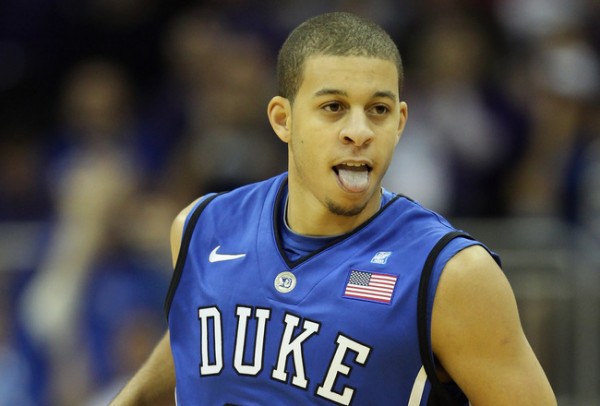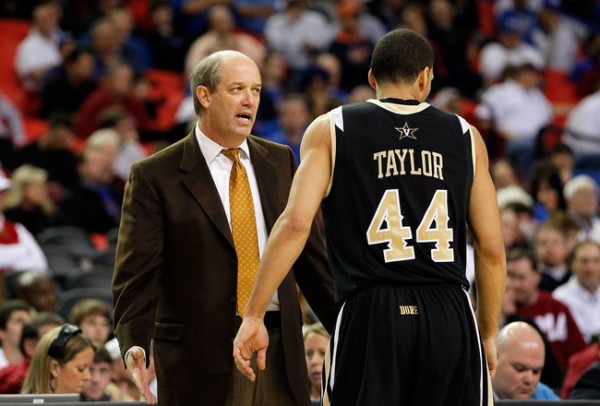Sizing Up Six Power Conference Teams Ready to Backslide
Posted by Chris Johnson on October 25th, 2012 Chris Johnson is an RTC Columnist. He can be reached @ChrisDJohnsonn.
Chris Johnson is an RTC Columnist. He can be reached @ChrisDJohnsonn.
The negative side of yesterday’s preview segment, which highlighted one team from each major conference ready to make the leap, are programs that look set to move the other way, to backslide into a less favorable place than the one they ended up in last season. Just as returning players and prized recruiting classes and injury recoveries presage improvement and success (at least theoretically), there are a host of other factors that can just as easily bring a team down. As I mentioned in yesterday’s precede, these factors are awfully tough to predict, because college hoops is an inherently unpredictable sport. Teams don’t always perform quite the way we expect. It happens. Some do, of course, and the following programs – in keeping with yesterday’s theme – represent one team from each power league that appears likely to take a step back in 2012. Not every team on the list is coming off a huge season. Regressing is a relative phenomenon. There are no restrictions on win totals or conference positioning or postseason success . Aside from last season’s truly dour outfits, the league bottom-feeders, everyone is in play.
Big 12 – Baylor

The return of Jackson and arrival of Austin is good news for Baylor, but it will be hard pressed to capture another Elite Eight appearance (Photo credit: Getty Images)
There’s a tendency to fall in love with NBA-bound players. Usually, they offer eye-popping athleticism, at least one or two extremely gifted traits that just plain jump off the screen and the general feeling that this whole college thing is but a mere stopping point along a path to a bigger and more-monied basketball future. These players are extremely fun to watch, if only for the fact that – this applies particularly to elite echelon of one-and-done guys – their time spent on a college hardwood is fleeting. Kentucky has embodied this ethos since hiring John Calipari in 2009. Needless to say, it’s been extremely effective. Now Baylor has adopted that mindset, and for the third straight season, they will have a super-hyped, extremely athletic, NBA-lottery-written-all-over-him big man in their lineup. I need not recount the story of Perry Jones III and the mostly disappointing career he had under Scott Drew. Because Isaiah Austin, the No. 1-ranked center in 2012 and No. 3-ranked overall player, might do it for me. Austin is a McDonald’s All-American with huge upside and potential. He also stands seven-feet tall and only 210 pounds. That’s the portrait of a Perry Jones III redux, only slightly taller. What’s more, scouting reports praise his versatility and his extended range, which is exactly what had scouts and NBA front office types so geeked up about Jones when he made his debut two seasons ago. I’m not saying Austin will be Perry Jones III. He could step on campus, flash a polished offensive game from day one, dominate the low post and exhibit the consistent effort and toughness Jones never developed. It’s just that Austin’s physical and observational profile is so similar to Jones’, and that – however statistically baseless a comparative measure – is reason to worry. If Jones belies this comparison with a monster season, the Bears – who bring back floor leader Pierre Jackson, long-range gunner Brady Heslip, and a cast of effective complementary players — may once again compete at the top of the Big 12. If not, this is an average team, destined for a middle-of-the-pack finish, with an immensely-talented freshman big man.
Big East – Connecticut
In hindsight, making this prediction a year ago would have been extremely prescient. The Huskies had peaked, quite literally, by attaining the highest honor this sport has to offer. There was no way the Huskies would reprise that success, even if Kemba Walker somehow had altered NCAA early entry eligibility rules to reflect an extra year of eligibility. The Huskies, despite losing their vocal and emotional leader, were nonetheless predicted to do very big things in 2011-12. Walker notwithstanding, UConn brought back most its championship roster, and welcomed in Andre Drummond, one of the top-two high school players in the Class of 2011. Things were looking up in Storrs. Another deep Tournament run was very much in the cards. One season later, one extremely restrictive academic shortcoming later (UConn is ineligible for the postseason after failing meet the NCAA’s four-year APR floor), and, perhaps most strikingly, one coaching change later, the Huskies have doubtless reached a nadir. Last season was disappointing enough: UConn finished 10th in the Big East, got bounced in the first game of the NCAA Tournament and endured maddeningly inconsistent play from Drummond throughout. Now that Calhoun has left the building (only in spirit, mind you – Calhoun still maintains an “advisory” role in the program), and assistant Kevin Ollie has been given a tenuous eight-month test-run at the school, UConn could fall even further. The Huskies’ one saving grace could be the backcourt, which brings back guards Shabazz Napier and Ryan Boatwright and adds four-star freshman Omar Calhoun. But without forwards Alex Oriakhi and Roscoe Smith, both of whom transferred Missouri and UNLV, respectively, or any other frontcourt players of consequence (Niels Giffey? Tyler Olander?), the Huskies are severely limited. Significant regression, even after last season’s mediocre finish, is a distinct possibility.
ACC – Duke

The Blue Devils will need more production from players like Curry to end the season in usual territory: with a top-four seed in tow (Photo credit: Getty Images).
The 29-point performance and game-winning buzzer beater Austin Rivers dropped on an unsuspecting UNC squad last season was one of the 2011-12 college hoops season’s best moments. Rivers was a remarkable talent. Perhaps too remarkable, or at least somewhat atypical of the Blue Devils’ team-oriented style of play. Rivers commanded 25.5 percent of Duke’s available shots last season, according to Ken Pomeroy’s efficiency statistics. On talent, he was easily the best player on the floor, but Rivers seemed to obstruct the free-flowing brand of basketball Coach K has built his program on. By the time Duke reached the NCAA Tournament, Patriot Conference upstart Lehigh exposed its flaws — namely, an incongruous style of play that hampered the rest of Duke’s lineup. Rivers is gone now, which means greater widespread offensive involvement, and a return to the type of pass-first attack we’re accustomed to seeing played at Cameron Indoor Stadium. Point guard Quinn Cook should have more backcourt freedom. Seth Curry will, after a season spent watching Rivers hog them, get plenty of open looks. Freshmen Amile Jefferson and Rasheed Sulaimon provide instant athleticism and scoring, both on the low block – where Jefferson can slide in to complement Ryan Kelly and Mason Plumlee – and along the perimeter. This is a talented team with significant pieces coming back. For Duke, whose single-season grading curve starts and ends with the Final Four, this is merely an average team. Don’t get me wrong: The Blue Devils will finish in the top half of the ACC. To expect anything less would be to ignore the last 32 years (and 854 wins, and 12 regular season league crowns and four National Championships). Doubting Coach K is foolish, and I have better ways to spend my preseason thoughts. Duke will be a solid team, with another NCAA Tournament bid on the way, but its ceiling feels lower than most years, and that lack of natural talent could restrict their ultimate potential.
Pac-12 – Washington
After a historically down season in the Pac-12 in which Washington won the league’s regular season title yet failed to reach the NCAA Tournament, it’s easy to forget the Huskies had two players selected in the first round of this year’s NBA Draft. Those players were Terrence Ross and Tony Wroten, the latter of whom was used on 32.2 percent of Washington’s possessions. Ross (23.4 percent) wasn’t all that far behind. Percentage-wise, that is a lot of possessions to replace. Washington will have a totally new look on offense this season. The good news is that senior point guard Abdul Gaddy and wings Scott Suggs and C.J. Wilcox, who averaged 14.2 points and 3.2 rebounds while hitting over 40 percent of his three point shots, are back to help offset the NBA exodus. That talented trio, while not nearly as talented as last year’s backcourt, is one of the better units in the Pac-12. The frontcourt picture is much less rosy. Seven-foot center A’Ziz N’Diaye is the only returning starter, which means sophomore Desmond Simmons, who posted an impressive 12.7 offensive rebounding percentage in limited minutes last season, will need to play a bigger role. Newly-eligible sophomore Shawn Kemp Jr. (yes, that Shawn Kemp) will join the mix after two years dealing with eligibility issues and temporarily signing with Auburn. And wunderkind tight end Austin Sefarian Jenkins – who, in what may mark my first use of football statistics in a basketball article, has amassed 447 receiving yards and three touchdowns – could provide help inside during conference play. N’Diaye is the most notable of that group, provided he can improve his offensive game while continuing his excellent glasswork (N’Diaye grabbed 21.1 percent of team’s misses last season) and rim-protecting prowess. That will help assuage Washington’s frontcourt concerns. It also runs the risk of going mostly unnoticed, because the sheer talent drop-off, combined with an overall improved Pac-12, will likely leave the Huskies out of the league title race, and well-short of NCAA Tournament territory.
SEC – Vanderbilt

Losing so many key players, like Taylor, leaves Vanderbilt with little hope of posting a respectable win total in 2012-13 (Photo credit: Getty Images).
This analysis begins with Vanderbilt’s recruiting class. It has to; otherwise, there’s not much to speak of, besides a team that lost its entire starting lineup from last season’s SEC Tournament championship outfit, including star center Festus Ezeli and perimeter scoring force Jeffery Taylor and guard John Jenkins, whom many believed to be the best three-point shooter in the country. The Commodores welcome in three recruits in the 2012 class, none of whom seem all that ready to play big minutes right away (though 6’ 6’’ shooting guards A.J. Astroth and Kevin Bright should find time off the bench). So unlike their SEC counterpart Kentucky Wildcats, there will be no quick-fix, freshmen-led voyage to glory. “Transition” will be the byword for Vanderbilt’s season; forecasting anything beyond a bottom-half SEC finish seems far-fetched. The silver lining to the Commodores’ massive roster turnover is the chance to see new players, presumably ones who will define the Commodores short-term basketball future. Guys like sophomore Kedren Johnson and junior Kyle Fuller will man the backcourt. Johnson flashed a well-rounded game in minutes last season, while Fuller dealt with personal issues that may have hampered his development. The rotational split remains uncertain, but a Johnson-Fuller point guard split is not an entirely bad situation to have. The lion’s share of perimeter scoring duties will fall on sophomore Dai-Jon Parker, who averaged 1.7 points per game but should increase that total with a bigger role. The Commodores’ most experienced player is Ron Odom, who alongside 6’ 8’’ Shelby Moats, will anchor the frontcourt. The lack of scoring and experience is jarring, but there is no team this side of Lexington capable of suiting up a completely revamped line up and actually, you know, winning. This is a building year for Stallings, a year to test the depths of his youthful roster, a year to find out who can help Vanderbilt return to its rightful place near the top the SEC power structure.
Big Ten – Ohio State
The release last week of this season’s first coaches poll brought a host of surprises. Chief among them was Ohio State, sitting at No. 4, ahead of Kansas and Michigan and several other promising teams. I fully expected coaches to rank Ohio State among the nation’s Top 25 teams. The Buckeyes have won at least a share of a Big Ten regular season title in five of the last seven seasons, and have a very good opportunity to build on that illustrious track record this year. I understand the hype. But a top-four ranking, which implies a trip to the elite semifinal round of NCAA Tournament play known as the Final Four is within their range, feels like a stretch. For the past two seasons, Ohio State basketball has been viewed through the prism of its star big man, Jared Sullinger. Now a member of the Boston Celtics, Sullinger won’t be around to dominate the paint and clear out defenders and draw defensive attention and all the other positive qualities he added to the Buckeyes’ offensive and defensive play. Gone too, lest we forget, is William Buford, a four-year starter who averaged 13.7 points and 4.7 rebounds over 145 games and 4,726 minutes. Buford’s the type of player whose loss hurts on-court production and chemistry just as much as it does continuity and leadership. Junior point guard Aaron Craft can help fill that gap, and breakout candidate DeShaun Thomas will embrace a more exalted perimeter scoring focus. There’s also plenty of young talent to be excited about. Sophomores LaQuinton Ross, Shannon Scott and Amir Williams, the shining stars of Ohio State’s vaunted 2011 recruiting class, will take on huge minutes and responsibilities this season. That’s all well and good. It’s not hard to figure out why most are buying the Buckeyes’ chances at another Big Ten title. Me, well, not so much. The Big Ten has at least two (and maybe three) teams – Indiana and Michigan (Michigan State) – with better rosters and more positive trajectories than Ohio State. When your path to a league title is in serious doubt – the Big Ten, top to bottom, is a bear, and even more loaded at the top – you are not the No. 4 team in the nation. Sorry! A good but not great season is a more realistic projection.













































About Duke,
remember back, way back, even before last year, when having an experienced team was the key to having a good season and going on a deep run in the NCAAs?